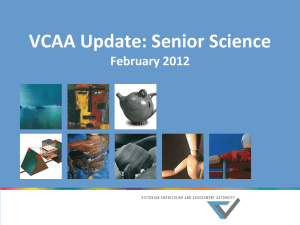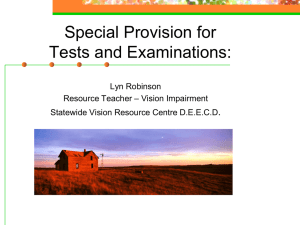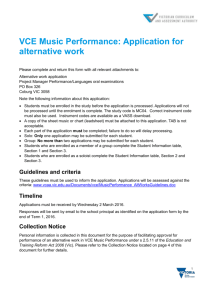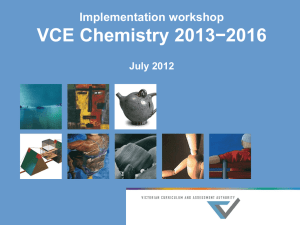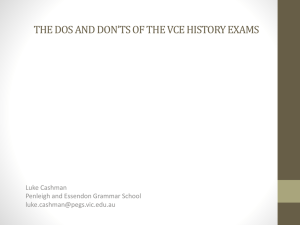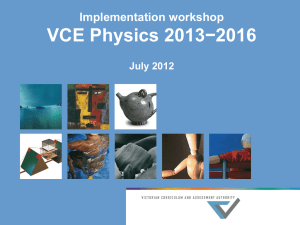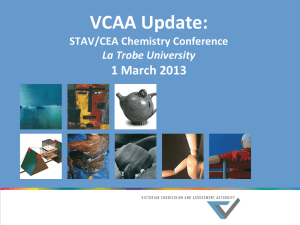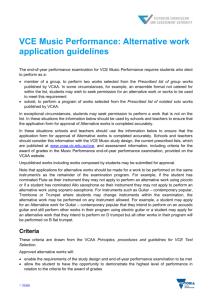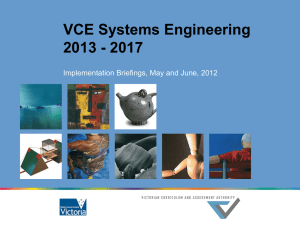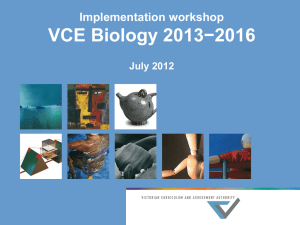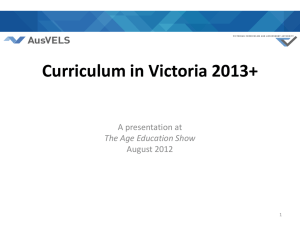VCE Product Design and Technology Study Design (2012–2016)
advertisement
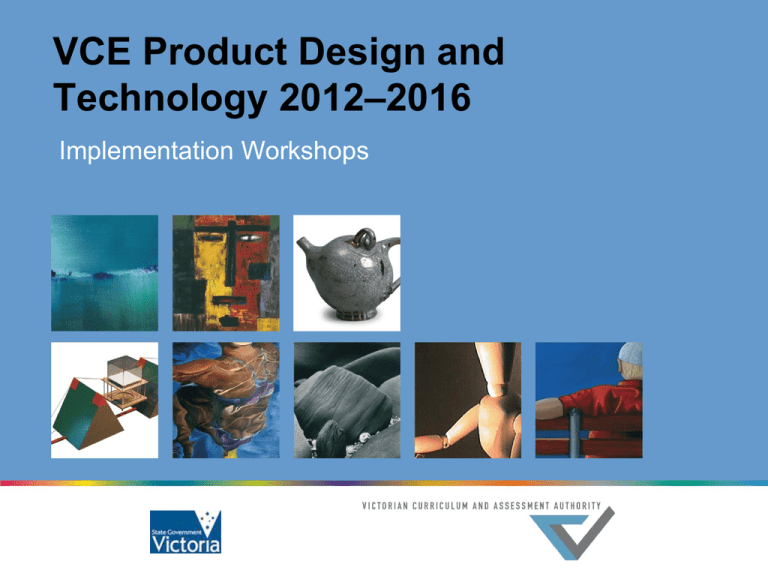
VCE Product Design and Technology 2012–2016 Implementation Workshops © Victorian Curriculum and Assessment Authority 2011 The copyright in this PowerPoint presentation is owned by the Victorian Curriculum and Assessment Authority or in the case of some materials, by third parties. No part may be reproduced by any process except in accordance with the provisions of the Copyright Act 1968 or with permission from the Copyright Officer at the Victorian Curriculum and Assessment Authority. 2 VCE Product Design and Technology Implementation Workshop VCE Product Design and Technology Units 1–4 (2012–2016) Implementation Workshops 2011 www.vcaa.vic.edu.au/vcaa/vce/studies/futuresd.html 3 Goals for the workshop • Introduce the reaccredited VCE Product Design and Technology Study Design (2012–2016) • Highlight the differences between new study design and the current study design • Review draft assessment criteria for the Schoolassessed Task and extract of the draft Assessment Handbook • Provide implementation ideas and opportunity for discussion/questions 4 The review process • Review occurred during 2010 • Panel comprised teachers from Independent, Catholic and Victorian Government schools, tertiary educators, and a designer • Terms of Reference guided the review • Consultation draft available for stakeholder comment • All feedback considered by review committee 5 VCE Product Design and Technology Study Design (2012–2016) Teachers should thoroughly familiarise themselves with the study design including: • • • • Introduction (page 7) Structure (page 8) Safety (page 9) Assessment and reporting (pages 10–11) • Cross study specifications (pages 12–15) • Units 1–4 (pages 16–38) • Advice for teachers (pages 39–69) - Glossary (pages 44–48) 6 General changes • cross study specifications – these apply to all units • some new titles and minor change in content in areas of study • greater clarity in some key knowledge and key skills dot points • elaboration of some content areas • a greater focus on sustainable practices, use of case studies, ICT and Intellectual Property (IP) 7 Scope of study (page 7) Scope of the study: - Product design process - Aesthetics, form and function - Social, economic and environmental factors including environmental sustainability - Tools, equipment, machines used to transform materials - Skills including design thinking, drawing, testing materials, planning, construction, evaluation 8 Rationale (page 7) Rationale of the study makes explicit: - Important role of designers - Understanding and applying knowledge of use of resources - Understanding consequences of product design - Developing creative solutions - How the study provides pathways to study and work in related fields 9 Cross study specifications (pages 12 and 13) • Product design process • Product design factors • Materials categories 10 Cross study specifications – Product design process (pages 12 and 13 ) 11 Cross study specifications – Product design factors (page 14) Product design factors are • referred to throughout the study • a revised version of the factors, fundamentals and applications in the current study design (page 36) • likely to be interconnected or overlap • used when – writing a design brief – analysing a product. 12 Design factors and parameters (page 14) • Purpose, function, and context • Human-centred design (human needs and wants) • Innovation and creativity • Visual, tactile and aesthetic (design principles and elements) • Sustainability (social, economic and environmental systems perspectives) • Economics – time and cost • Legal responsibilities • Materials – characteristics and properties • Technologies – tools, processes, and manufacturing methods 13 Cross study specifications – Materials categories (page 15) Three categories of materials used to make products in this study are listed Also listed are the design specialisation areas • Units 1 and 2 – materials in any category can be used • Units 3 and 4 – materials in Category 1 used predominately but may incorporate Category 2 • Units 1 to 4 – materials from Category 3 are for finishing, fastening, decorating and used in conjunction with Category 1 and 2 materials 14 Structure of the study Four units: Units 1 and 2 have two areas of study; Units 3 and 4 have three areas of study. Product design process is embedded in each unit. Unit 1: Product re-design and sustainability • Area of Study 1 – Product re-design for improvement • Area of Study 2 – Producing and evaluating a re-designed product Unit 2: Collaborative design • Area of Study 1 – Designing within a team • Area of Study 2 – Producing and evaluating a collaboratively designed product 15 Structure of the study Unit 3: Applying the Product design process • Area of Study 1 – The designer, client and/or end-user in product development • Area of Study 2 – Product development in industry • Area of Study 3 – Designing for others Unit 4: Product development and evaluation • Area of Study 1 – Product analysis and comparison • Area of Study 2 – Product manufacture • Area of Study 3 – Product evaluation 16 Structure of the study Key knowledge Key skills Provides content Provides application For example: • explain • investigate • evaluate • analyse • use/apply 17 Advice for teachers This section includes advice on: • developing a course • explaining specific terms used throughout the study design (glossary, pages 44–48) • relationship of the study to AUSVELS (pages 39 and 40) • employability skills (pages 40 and 41) • learning activities (pages 49–67) • sample assessment program (pages 68 and 69) 18 Unit 1 Area of Study 1 – Product re-design for improvement (page 16) Outcome 1 Re-design a product using suitable materials with the intention of improving aspects of the product’s aesthetics, functionality or quality, including consideration of sustainability. 19 Developing and responding to evaluation criteria Criteria When this criteria is developed When to respond to this criteria Design option criteria After the design brief has been developed: used in decision matrix While/after the design options have been developed Design planning and production criteria After the design brief has been developed: additionally after design options are completed Evaluation report, draws on record of progress and modifications Final product criteria After the design brief has been developed In the evaluation report after the product has been made and tested/checked 20 Unit 1 Area of Study 2 – Producing and evaluating a re-designed product (page 18) Outcome 2 Use and evaluate materials, tools, equipment and processes to make a re-designed product or prototype, and compare the finished product or prototype with the original design. 21 Unit 2 Area of Study 1 – Designing within a team (page 21) Outcome 1 Design and plan a product, a product range or a group product with component parts in response to a design brief based on a common theme, both individually and within a team. 22 Unit 2 Area of Study 2 – Producing and evaluating a collaboratively designed product (page 23) Outcome 2 Justify, manage and use appropriate production processes to safely make a product and evaluate, individually and as a member of a team, the processes and materials used, and the suitability of a product or components of a group product against the design brief. 23 Unit 3 Area of Study 1 – The designer, client and/or end-user in product development (page 26) Outcome 1 Explain the roles of the designer, client and/or end-user/s, the Product design process and its initial stages, including investigating and defining a design problem, and explain how the design process leads to product design development. 24 Annotated design brief Adam Jahnke, Top Designs 2009 25 Unit 3 Area of Study 2 – Product development in industry (page 28) Outcome 2 Explain and analyse influences on the design, development and manufacture of products within industrial settings. 26 Unit 3 Area of Study 3 – Designing for others (page 29) Outcome 3 Present a folio that documents the Product design process used while working as a designer to meet the needs of a client and/or an end-user, and commence production of the designed product. 27 Example of a decision matrix for a design option Adam Jahnke, Top Designs 2009 Weighting Ranking Total score for design option 4 28 Unit 4 Area of Study 1 – Product analysis and comparison (page 33) Outcome 1 Compare, analyse and evaluate similar commercial products, taking into account a range of factors and using appropriate techniques. 29 Unit 4 Area of Study 2 – Product manufacture (page 34) Outcome 2 Safely apply a range of production skills and processes to make the product designed in Unit 3, and manage time and resources effectively and efficiently. 30 Unit 4 Area of Study 3 – Product evaluation (page 35) Outcome 3 Evaluate the outcomes of the design, planning and production activities, explain the product’s design features to the client and/or an end-user and outline its care requirements. 31 Units 1 and 2 assessment (p 20 and 24, 25) Slight changes have been made to the assessment task types, but essentially the same as in the current study design • folio (Outcome 1) • product and record of work (Outcome 2) • multimedia • short written report • oral report 32 Assessment of Units 3 and 4 Unit Outcome Unit 3 Outcome 1 Outcome 2 Schoolassessed Coursework Outcome 1 8% Outcome 3 % of study score 7% Outcome 2 20% November exam 5% Outcome 3 Unit 4 Schoolassessed Task 50% 30% 33 Assessment Handbook The parts of the Product Design and Technology Assessment Handbook are: – Introduction – Assessment – Assessment advice – Sample approaches Using the assessment handbook – designing the tasks, using performance descriptors and assessment criteria 34 Resources A list of resources for the new study is provided on the VCAA website. Resources list will be updated annually. Provide suggestions for additional resources by email to Lorraine Tran. 35 Assessment advice timeline Published annually in the VCAA Bulletin each February Submission and Audit of Unit 3 Coursework – August Visitation Review and Submission and Audit of Unit 4 Coursework – October/November Feedback on Visitation Review – December 36 Professional development for teachers • SAT information days held annually at VCAA assessment centre, Coburg, Term 1. Dates published in the VCAA Bulletin and Memorandum to schools and online at the relevant study pages http://www.vcaa.vic.edu.au/vce/studies/foodtech/foodtechindex.html – Review folio work – Unpack assessment criteria and apply to student work • Attend Top Designs 37 Professional development for teachers Apply to be a reviewer for School-assessed Task visitation http://www.vcaa.vic.edu.au/vce/exams/vceassessor.html www.ssms.vic.edu.au Applications to be an examination assessor via SSMS General enquiries – VCE Examinations Ph: (03) 9225 2349 38 Bulletin online • The VCAA Bulletin VCE, VCAL and VET is now online • A free subscription is available at www.vcaa.vic.edu.au • Follow the prompts to the subscription page and enter your details • Ensure your email address is entered correctly 39 Contact Details Victorian Curriculum and Assessment Authority (VCAA) Curriculum Manager – Product Design and Technology Ph: (03) 9651 4407 Fax: (03) 9651 4324 www.vcaa.vic.edu.au 40

